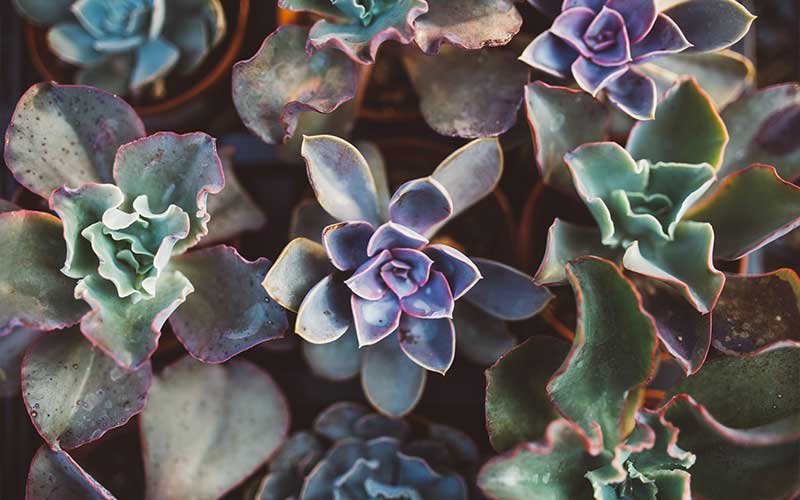Contents
Succulents are valued for their beauty and ability to withstand harsh conditions. They have unique qualities that help them grow and thrive even with minimal care, but like other plants, they are not immune to problems. However, they do show symptoms when they are unhealthy, so you’ll know if it’s time to change something in their environment or in the way you care for them.
If you’re unsure whether your succulent is behaving normally or is telling you that it needs more attention, the information below will help you spot signs of problems with your succulents and give tips on how to troubleshoot them.
Common Succulent Problems
Leaves are Falling Off
The most common reason for the leaves of your succulent to fall off is issues with watering. Overwatering can cause the leaves to swell, become soft and mushy, and fall off. The stem of an overwatered succulent will look puffy, while the leaves will appear wet and sloppy.
Solution: Refrain from watering your plant until the top inch of the soil is dry. Make sure the potting mix is fast-draining, and the pot has enough drainage holes, so your plant doesn’t sit on water for too long. If you are using the wrong potting mix, switch it out with a fast-draining soil mix. If your pot doesn’t drain well, drill holes into it or change the frequency of watering.
The leaves can also off when the weather is scorching. When there is intense heat or drought, succulents adapt by dropping their leaves so they can conserve energy and preserve their water supply. This is your succulent’s natural response to the stress in its environment, but there are things you can do to minimize its effects on your plant.
Solution: Move your plant away from full, direct sunlight during a heatwave or drought. Also, consider watering it more frequently than usual under these conditions. Water your succulents once you notice that the top inch of the soil is parched.
Yellow Leaves

Solution: Change your watering techniques. If your plant is overwatered, make sure the soil is already dry before you water it again. If it is underwatered, increase the amount of water you give and be sure to drench it thoroughly when you water it. Most succulents enjoy a good drench until excess water drips out of the potholes. Water it again when the soil dries out.
Leaves can also turn yellow because of the lack of nutrients. Most succulent soils sold in stores contain fertilizers that your plants can feed on for some time, but as time goes by, these nutrients are flushed out of the soil due to watering.
Solution: You can add more nutrients by adding fertilizer to the soil. Use a fertilizer designed for houseplants or specially made for succulents. Succulents do not need a lot of fertilizers. Half of the recommended amount will do. Fertilize your plants once every two weeks during the growing season, and don’t fertilize them when they are dormant. If you are going to replant your succulent, make sure you use a well-draining pot with a fresh soil mix.
Withered or Shriveled Leaves
Underwatering is the leading cause of withered leaves in succulents. If the leaves appear wilted, which usually starts from the top of the plant, then the plant needs more water.
Solution: Underwatering problems are easy to troubleshoot. Water the plant more thoroughly and frequently. Increase the frequency during drought or heatwave. Water your plant until the water starts dripping from the drainage holes of the pot. Water it again when the soil becomes dry.

Brown Leaves or Brown Spots on Leaves
If the leaves of your succulents are turning brown or if you see brown spots on them, they are likely sunburned. Sunburn can happen if your plant is exposed to too much direct sunlight, or if there was a sudden change in its sun exposure.
Remedy: Move the plant to a shadier location, especially during a heatwave. Before you move a plant to a sunnier spot, make sure to acclimatize it first. Gradually increase the sun exposure to prevent sun damage. Do not place newly propagated plants under the full sun, so they don’t get scorched.
Stunted Growth
If you do not see new growth in your plant, it may be getting insufficient light. Plants that do not receive sufficient light will not grow well. They will stretch out and will not produce any new growth.
Solution: Move your plant to a location with better lighting. Be careful not to shock your plant by suddenly moving it form low light to full sun. Acclimate your plants to avoid sun damage. Observe how your plants are reacting to the adjustments, and adjust accordingly.
Lack of nutrients may also stunt your plant’s growth. If your plant has been on the same pot for more than a year, it may be time to transfer it to a new container with fresh soil mix or time to fertilize.
Solution: Re-pot the plant in a new soil mix, or add minimal fertilizer once every two weeks during the growing season.
Whether or not your plants will survive these problems depend on the extent of damage and how immediately you troubleshoot them. The best way to gauge the extent of damage is to examine your plant from top to roots. If you see enough roots that are still viable, then your plant can survive if you care for it properly. But if all the roots have dried up and turned black, the survival chance of your plant is slim.
If your succulents are suffering from any of these problems, be careful to follow all the tips we have shared so that they become healthy and thriving in no time!


